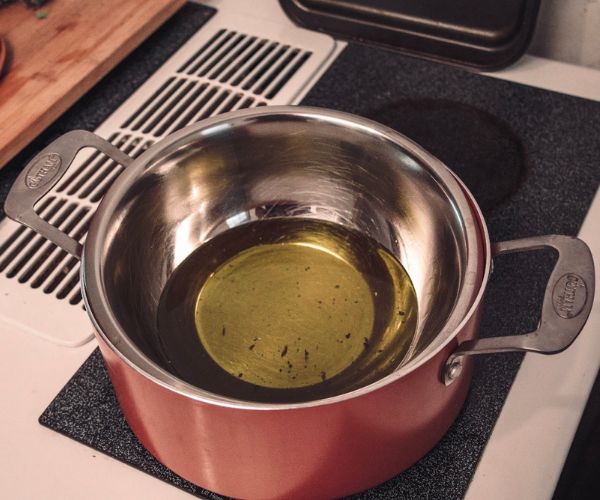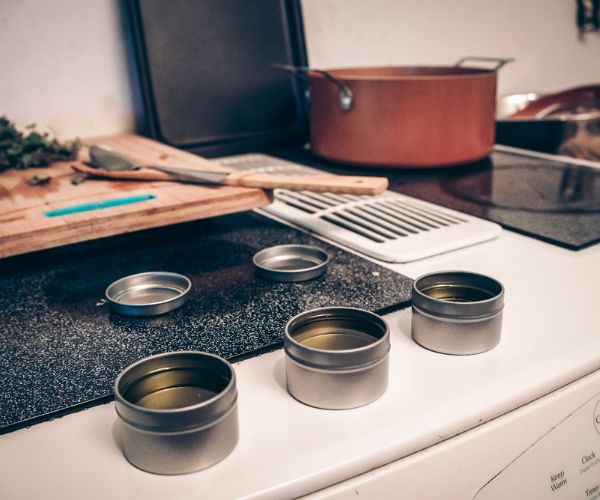Purple dead nettle might just kill your pain.
It’s one of the most medicinal weeds around, boasting powerful anti-inflammatory properties that can soothe arthritis flare-ups, quell joint soreness, and relieve muscle aches.
Making a medicinal salve is one of the best ways to utilize these properties. Read on to learn how to make purple dead nettle salve at home.
Materials to Make Purple Dead Nettle Salve

You’ll need to gather your materials first. Keep in mind that the process does require several steps. Depending on your preferences and tools, it may take several days, weeks, or even months. Here’s what you need:
- Purple dead nettle: Purple dead nettle is the star of the show, infusing the salve with potent healing properties. It must be dry to prevent spoilage and concentrate the medicine.
- Carrier oil: The carrier oil acts as a medicinal conduit that adds therapeutic value and locks in moisture to the skin. You can use any liquid oil that you prefer. I will forever choose olive oil, but coconut, argan, and avocado oil are also popular options.
- Beeswax: Beeswax preserves the salve’s structural integrity and adds solidity to the final product. Beeswax pellets or pastilles work best because they’re easy to divide and measure. If you’re vegan or have a beeswax allergy, use soy wax instead.
- Stove: You will heat the beeswax and oil together on the stove, combining them into a homogeneous mixture to create the salve.
- Double-boiler setup: The double-boiler provides gentle, diffuse heat and prevents scorching. You don’t need a dedicated double-boiler. You can set one up using a heat-safe bowl and a large pot.
- Storage containers: Get lidded glass or tin storage jars to store the salve safely and extend its shelf-life. Most salves come in one- or two-ounce tins, but you can use larger containers of up to six ounces if you prefer.
- Kitchen scale: Use a kitchen scale to get exact measurements, leaving less room for error. If you don’t have a kitchen scale, use measuring cups and spoons instead.
How to Make Purple Dead Nettle Salve
1. Harvest the Nettle
Head for the great outdoors and gather as much purple dead nettle as you want. You need at least one part of dried herbs for every five parts of carrier oil, but it isn’t imperative to harvest an exact amount as long as you harvest enough. You can use purple dead nettle in many ways, so having extra is never an issue.

2. Dry Your Herbs
Fresh herbs contain water that makes salve spoil quicker, so it’s essential to dry the nettles. Lay them on paper towels or wire racks with plenty of space between them. Leave them to air-dry for three to seven days. You could also use a dehydrator set at 95° F for four to nine hours. Do not use the oven.
Once the nettles crumble easily in your hands, they’re dry enough. Test one of the plants, but resist the urge to crumble them all into dust. Having whole plants or at least larger pieces will make the infusion process and subsequent straining much easier.

3. Measure Your Ingredients
Once you have the dried herbs, you can measure everything out. You’ll need a one-to-five ratio of plant parts to oil to make the oil infusion and a one-to-five ratio of beeswax to oil for the salve itself.
The one-to-five ratio creates the texture we know and love in salves—soft, smooth, and easy to smear. Using more wax will make a solid balm, and using less will make an oily disaster in your kitchen.
You can use the one-to-five ratio to create the perfect amount of salve for yourself. Here’s what I usually use:
- 10 ounces of oil
- Two ounces of purple dead nettle
- Two ounces of beeswax
My recipe makes about twelve ounces of salve.
Measure everything out using your kitchen scale. If you don’t have one, I highly recommend this scale. You can measure in different units and tare it to measure liquids within receptacles. It makes life a lot easier, especially when converting recipes.

4. Infuse the Oil
You can’t put plants directly into the salve. It would create a gritty, unpleasant experience and wouldn’t allow you to extract the full range of benefits. Instead, you infuse the carrier oil with herbs using heat or time. There are several ways to do this.
Have a lot of patience? Place your dried nettles in the bottom of a jar, then fill the jar with your carrier oil. Set it in a dark place and leave it to infuse for one to two months.
If you need a faster infusion, place the herbs and oil in your double-boiler. Don’t let it boil, but leave the water to simmer for one to three hours and monitor it closely to ensure it doesn’t scorch.

5. Strain the Oil
When the oil is infused sufficiently, it’s time to strain it. If you use whole dried herbs, you will only need a colander to strain them. If the pieces are too small, you can use a cheesecloth. Press down on the herbs to squeeze all the oil out as you strain them.

5. Heat the Salve
Put the double-boiler on and dial your stove to a medium-level heat setting. Once it’s simmering, add the infused oil and beeswax pellets. Stir them gently, and do not leave during this process. You need to keep stirring and make sure they combine effectively.
It should only take a few minutes for the wax to melt and disappear. Once you have a clear, homogeneous mixture, there’s no need to leave it on the heat any longer.


6. Pour Off
Turn off the double boiler but don’t let the mixture cool down too much. Salves fresh off the stove are in liquid form but harden as they cool, and you don’t want yours to set before you jar it.
While it’s still liquid, pour it into your storage container. Leave the lid off the containers until the mixture hardens.

7. Store and Enjoy
Once the salve has turned an opaque greenish-white, it is ready. Store the salve in a cool, dark place. It should stay potent, fresh, and usable for up to a year.
To extend the shelf life, put extra salve tins into the fridge. You can even store open salve jars in the refrigerator, but make sure to bring them to room temperature before you use them, or they won’t spread.

Tips to Optimize Your Salve
Purple dead nettle is potent on its own, but you can amplify its capabilities by combining it with essential oils or other medicinal plants, like yarrow, comfrey, and dandelion.
Mix in Medicinal Plants
To incorporate additional plants into the recipe, substitute half your dried nettle for an equal portion of the alternative plant as you infuse the oil. Some people (like me!) keep a cache of pre-infused oils at home to mix and match oil infusions and create functional salves for specific purposes.
For example, subbing half of your purple dead nettle oil for comfrey oil will leave you with a relieving, antiseptic salve perfect for insect bites and fungal infections.
Add Essential Oils
Adding essential oils to salves will enhance their medicinal capabilities and improve their aroma. Two to four drops of tea tree oil will create a salve suitable for cuts and scrapes, while peppermint oil will enhance the salve’s ability to soothe muscle aches.
To add essential oil, wait until you have poured the salve into the storage jars. Essential oils are chemically unstable and degrade very quickly, so adding them at the last possible second will preserve their medicinal capabilities and enhance the overall function of the finished product.
Now that you know how to make purple dead nettle salve, you’re ready to take advantage of all the benefits this plant has to offer. Head outside and get to foraging today!


Looks great, but your comment about “subbing half of your purple dead nettle oil for comfrey oil” is really confusing. Isn’t that backwards? It’s saying to substitute purple dead nettle oil for comfrey oil, and that’s completely backwards from what I think you’re trying to suggest. If you want to use comfrey oil for half of the total oil, you would say ‘substituting comfrey oil for half of the purple dead nettle oil,” not the other way around.
I have this salve. It has improved my dry lips measurably. It WORKS!